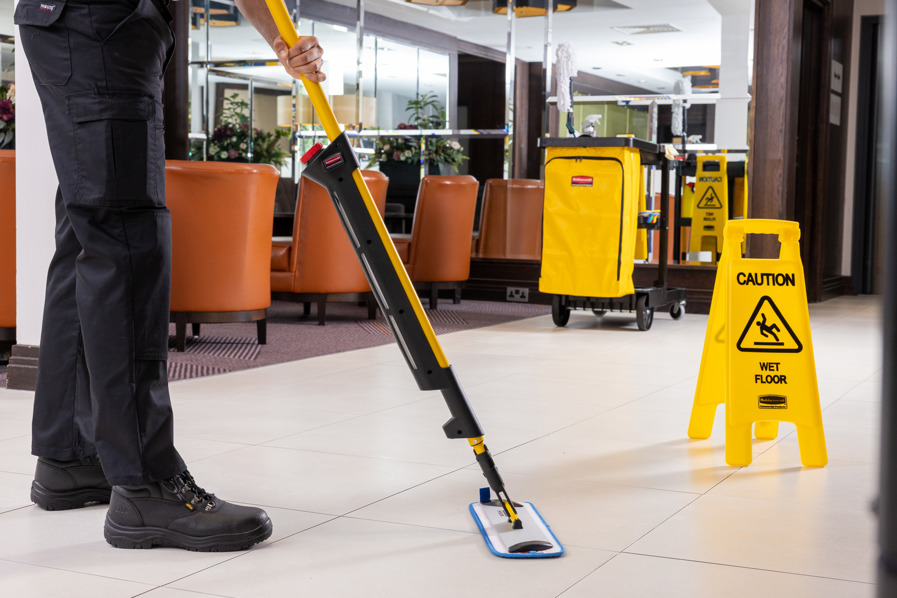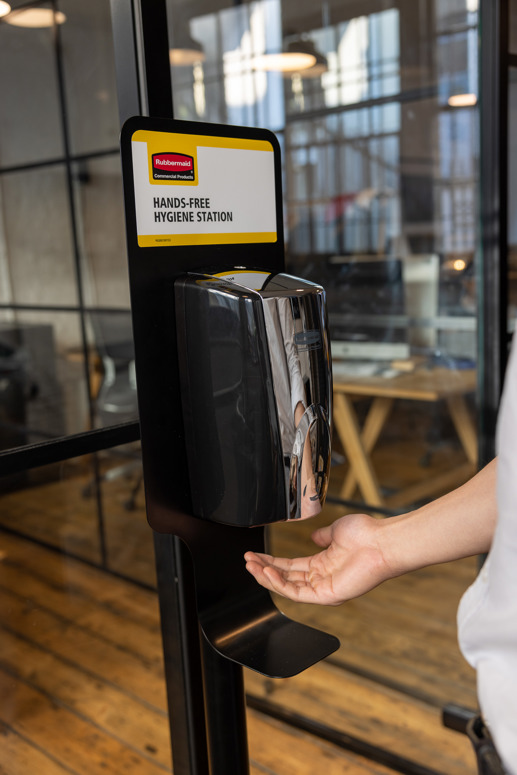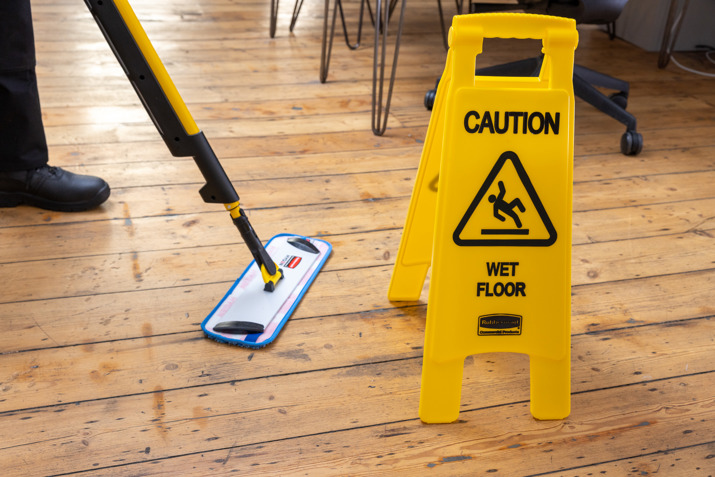
A tidy workplace reflects how well safety and responsibilities are managed on-site. Good workplace housekeeping plays a vital role in preventing hazards, supporting clear work procedures, and reducing the likelihood of injuries. When cleaning becomes an integral part of daily routines, it creates a safer environment for everyone.
Building a strong safety culture starts with understanding how effective workplace housekeeping directly contributes to improved health, safety, and productivity in the work environment.
Poor housekeeping creates real risks. Wet floors, cluttered walkways and blocked emergency exits increase the chance of serious injury. These are not small mistakes. They are safety issues that affect workers, contractors and visitors.
In Australia, slips, trips and falls are responsible for more than 25 percent of serious injury claims, according to Safe Work Australia. Many of these incidents happen in places where basic housekeeping is overlooked. Floors are not cleaned properly. Storage areas are disorganised. Waste is left out for too long.
Workplace housekeeping supports a safer and more productive environment. It keeps hazardous substances out of the way. It helps equipment stay where it belongs. It also supports safer work routines and improves how teams operate.
If you manage a commercial space or shared facility, explore our cleaning systems for offices. These solutions help staff keep the workplace cleaner and safer with less time and effort.
Cleaning routines work best when they follow a clear structure. Setting a schedule helps workers stay focused and makes cleaning more consistent across all areas. By dividing tasks into daily steps and longer cycles, teams can keep the workplace safer and more organised without wasting time or effort.
|
Frequency |
Key Tasks |
Responsible Team or Role |
|
Daily |
• Spot mopping • Waste disposal • High-touch surface cleaning |
All staff and cleaning personnel |
|
Weekly |
• Deep clean of storage areas • Shared surfaces and equipment • Check tools and clutter |
Facilities team or assigned cleaning crew |
|
Monthly |
• Stock take • Replace mop heads and cloths • Review signage • Clear build-up in low-traffic areas |
Supervisors or maintenance leads |
Daily cleaning tasks play a major role in keeping the workplace safe and orderly. The focus should be on work surfaces, walkways, shared touchpoints and waste disposal. Spills should be cleaned immediately, and rubbish removed before it starts to overflow. Surfaces in kitchens, toilets and break areas need extra attention, especially in shared or high-traffic spaces.
Floors are one of the most common areas where safety issues start. Daily mopping helps reduce the risk of slips and keeps the space looking professional. Using a mop system that reduces splash and is easy to wring helps staff clean more quickly with fewer disruptions. Rubbermaid’s Pulse™ Microfibre Mop Kit is designed for this type of daily use.
Wiping down desks, handrails, doorknobs and light switches with cloths that lift dirt without leaving streaks also supports better hygiene. HYGEN™ microfibre cloths are used by cleaning teams across commercial buildings to support effective cleaning with less chemical use.
Daily hygiene tasks should also include checking that sanitiser stations are stocked and accessible. Rubbermaid’s AutoFoam dispensers offer a contactless option that helps promote regular hand cleaning throughout the day.

Weekly tasks give teams time to catch risks that daily cleaning often skips. This includes cluttered storage areas, unused materials, blocked air vents and signs of poor housekeeping practices. A good housekeeping program builds these checks into the schedule to support better work practices and reduce workplace hazards.
Storage rooms, cupboards and shared equipment zones should be cleared and cleaned properly. Dust, spills and poor lighting in these areas can lead to physical hazards if left unchecked. Removing waste materials and securing dangerous chemicals are essential parts of effective housekeeping. Use appropriate bins to sort rubbish and keep materials in order.
Weekly cleaning also allows facilities teams to check tools, refill supplies and reorganise carts. Our High-Capacity Cleaning Carts are useful here—they help cleaning teams carry everything needed across large spaces without repeat trips. When paired with colour-coded HYGEN™ cloths, teams can move between zones with less risk of cross-contamination.
Management can also include a short reminder in toolbox talk sessions to keep employees aware of their housekeeping responsibilities. These routines support health and safety, reduce accidents occurring and make more effective use of time, equipment and staff.
Monthly housekeeping gives teams a chance to step back and review what’s working and what needs to change. It supports long-term maintenance by identifying slow build-up of waste, worn-out tools or forgotten supplies. This is when good housekeeping practices shift from routine cleaning to overall risk management.
Start by reviewing storage areas. Look for materials that are expired, broken or no longer used. Dispose of these using appropriate bins and reset stock levels for cloths, mop pads and disinfectants. Rubbermaid offers durable microfibre systems that hold up to repeated use and can be restocked easily to maintain cleaning performance.
Review signs, lighting and hygiene stations. Missing signs and dim lighting are common causes of poor housekeeping. Restock or reposition AutoFoam dispensers if they’re being underused. Check that floor safety signage is visible and easy for other workers and coworkers to access.
This is also a good time for supervisors to walk through the site and make note of problem areas. Monthly checks help reinforce the basic principles of effective housekeeping—remove hazards, stay orderly and make it easier for employees to keep the workplace safe.

Clean floors and clear surfaces reduce the risk of injury, help teams work faster and support better hygiene. But poor housekeeping practices—like clutter, dirty corners or forgotten tools—can undo daily efforts. These practical actions help maintain an orderly space and build better habits across shifts.
Remove clutter from walkways and shared zones
Items left in hallways or near workstations can trip staff or restrict access to emergency exits, creating serious safety risks. It is essential to clear these spaces thoroughly at the start and end of each shift to support safer movement, reduce workplace hazards, and maintain a clear, accessible path for everyone.
Return tools and materials after use
Tools left out are a hazard. Always store them where they belong once tasks are completed. This reduces risks such as trips, falls, and injuries, and makes it easier for other workers to find what they need quickly. Proper tool storage supports a safer, more efficient, and organized work environment.
Use cleaning carts to stay organised while working
Rubbermaid’s High-Capacity Carts carry cloths, sprays, bins, and other essential cleaning supplies all in one convenient place. These carts help staff move seamlessly between tasks and locations without wasting time searching for tools.
Wipe surfaces using colour-coded microfibre cloths
Touchpoints like desks, switches, and handles collect germs quickly throughout the day. Using HYGEN™ Microfibre Cloths in different colours supports safe cleaning practices by preventing cross-contamination between areas. It reduces the spread of germs and helping maintain a healthier workplace overall.
Mop spills right away to avoid slips
Spills cause slips and slow down foot traffic, creating significant safety hazards. Act quickly using a mop system like WaveBrake®, which reduces splash and efficiently keeps walkways dry. Always place wet floor signs while cleaning to warn coworkers and prevent accidents.
Clean low-visibility areas like corners and under desks
Dust, dirt, and rubbish often accumulate in areas that people don’t regularly inspect, such as corners, under furniture, and behind equipment. Adding these overlooked spots to your weekly cleaning plan helps avoid hidden risks.
Check lighting in storage and service areas
Poor lighting makes hazards harder to spot. Replace broken bulbs promptly and report any dim or shadowy areas.

When cleaning supplies are hard to access, daily housekeeping falls through the cracks. If cloths, bins or mops are locked away or placed too far from work areas, staff are less likely to act on spills, clutter or rubbish.
Place cleaning carts in visible, shared spaces where teams can grab what they need without delay. Staff should not have to ask where to find basic tools. Rubbermaid’s High-Capacity Cleaning Carts are designed to store everything in one place—wipes, liners, sprays and cloths—making movement between rooms easier and faster.
AutoFoam Sanitiser Dispensers should be placed near entryways, break rooms, toilets and other high-traffic zones. These stations promote better hygiene and act as a visible cue to clean more often.
When tools are easy to reach and ready to use, staff are more likely to clean as they go. It also helps contractors and visitors maintain the same standards without needing instructions.
Good housekeeping depends on how well people take responsibility for the space around them. Employees, contractors and casual staff should all understand the role they play in keeping work areas clean, clear and safe.
Start by making expectations easy to follow. Use toolbox talks, team briefings or workplace signage to remind staff of their cleaning duties. Focus on daily habits like wiping surfaces, reporting spills and returning tools. These tasks are quick, but they help reduce workplace hazards before they turn into safety issues.
Managers should set the tone. When supervisors follow good housekeeping practices, it becomes part of the routine for everyone. Walkthroughs by team leads are a good way to spot problems—such as bins that haven’t been emptied, clutter near exits or tools left in shared spaces.
Provide staff with the right tools to act fast. Mobile Safety Barriers and Floor Signs are easy to move and help workers mark cleaning zones or spill areas right away. This keeps others aware and prevents accidents while the area is being cleaned.
When everyone is involved, cleaning becomes part of the workday, not an extra job. That mindset creates safer routines and stronger work practices across all departments.

Rubbermaid Commercial offers cleaning tools designed to help teams stay organised, act fast and maintain high standards across shared spaces. Whether you manage an office, healthcare facility or retail site, we can help you build a system that fits your needs.
Explore our workplace cleaning solutions or speak to a product specialist today.